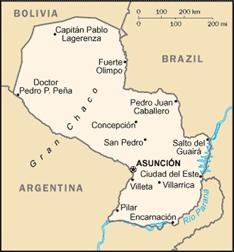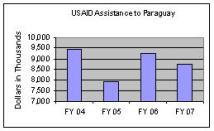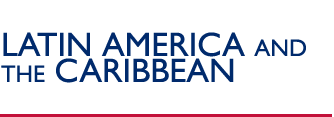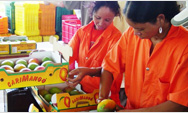
Many of the poor in Paraguay have almost no access to medicines and medical supplies. USAID started a pilot community pharmacy program directed to provide low cost medicines. Now approximately 20,000 low income families benefit from the program, but the number is expected to substantially increase in 2008 with the expansion of the program into a new Department (Misiones). The social pharmacy program contributes to reducing infant mortality caused by diarrhea and respiratory infections.

Paraguay Snapshot
Date of independence: 14 May 1811
Population: 6,506,464
Income per person: $4,740 (yr)
USAID in Paraguay
http://paraguay.usaid.gov
|

CONTACT INFORMATION
Mission Director
John Beed
USAID Paraguay
Tel: (55-21) 220 715 ext 101
E-mail: jbeed@usaid.gov
Paraguay Desk Officer (Washington)
Michael Karbeling
(202) 712-0769
MKarbeling@usaid.gov |
|
Overview
With an estimated 6.1 million people, Paraguay ranks as the second smallest country in Latin America. The economy is fundamentally agrarian with agriculture and agribusiness representing about 40% of output and employment. Paraguay heavily depends on exports and prices of a few key commodities such as cattle, soybean, cotton, and wood. Poverty rates have fallen from 46.2% of the population in 2002 to about 38% in 2005. Remittances have increased significantly over the years, from approximately $200 million in 2000, to $550 million in 2005. With an estimated 2.1% annual population growth rate, Paraguay faces many challenges when:
- The national unemployment rate is 7.3%, with an average of 13.4% among the group between 15 to 24 years; the national sub-employment rate is 24%.
- Over 40% of the population lives in rural areas.
- Maternal mortality rates are among the worst in Latin America and progress has been minimal.
- Paraguay’s deforestation rate is among the highest in Latin America.
- Sustainable development in Paraguay is threatened by the indiscriminate exploitation of land, water, and wildlife resources.
Some of the obstacles impeding Paraguay’s development are weak institutions, an informal economy, and corruption. Although the Government of Paraguay (GOP) has improved macroeconomics and domestic debt, customs service, and the tax system, much remains to be done. USAID’s program focuses on strengthening democracy and governance, economic growth, reproductive health, and the environment. USAID also is implementing a two-year Millennium Challenge Corporation (MCC) Threshold Program.
Programs
Democracy
The Democracy Program works to strengthen the building blocks of democracy by supporting the development of a politically active civil society that empowers individuals to organize, express their views publicly, and debate public policies openly. Support is provided to strengthen government institutions, particularly local government, to encourage transparency and accountability, and improvements in public services. USAID also works with the judiciary and the Public Ministry to improve access to the justice system.
Health
Unequal access to quality health services presents a major obstacle to achieving overall health improvements, as well as economic and social development. The Health Program focuses on family planning by working with national and local governments and Paraguayan non-governmental organizations (NGO) to improve health services. The program also assists the GOP in improving its health information system so that it can better define policies and direct resources to priority programs.
Environment
The Environment Program seeks to protect key eco-regions from the threats posed by deforestation, urban expansion and pollution, and the un-sustainable use of natural resources and biodiversity. USAID also represents the U.S. Government (USG) on the board which implements a debt-for-nature swap under the Tropical Forest Conservation Act agreement between the USG and the GOP.
Economic Growth
The Economic Growth Program works towards supporting Paraguayan companies and entrepreneurs to expand their sales and reduce poverty through job-creation. The Program supports the development of new products and eliminates the barriers to export products, helping companies to find new markets for greater trade opportunities.
Oportunet, Internet Access
It is estimated that fewer than 13% of Paraguay’s youth have access to the internet. In partnership with a leading private NGO, USAID started a program to install internet access in schools, clinics and agricultural cooperatives in approximately 100 sites around the country, making internet services available in cities and towns located in isolated places.
MCC Threshold Program
USAID is implementing a two-year MCC Threshold Program aimed at fighting corruption by reducing impunity and promoting formal economic activity. The program benefits 28 government institutions. It is scheduled to end in late CY 2008; however, Paraguay has been invited to submit a Stage II Threshold Program proposal.
|


